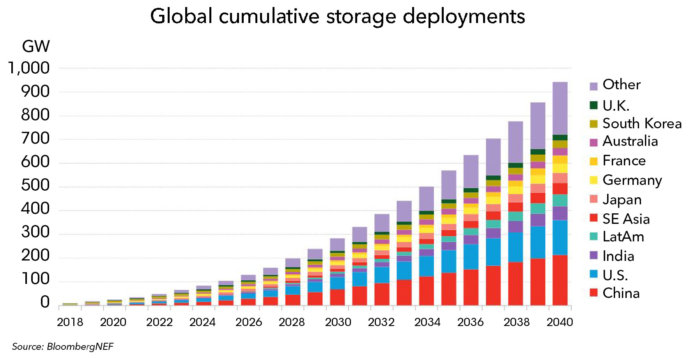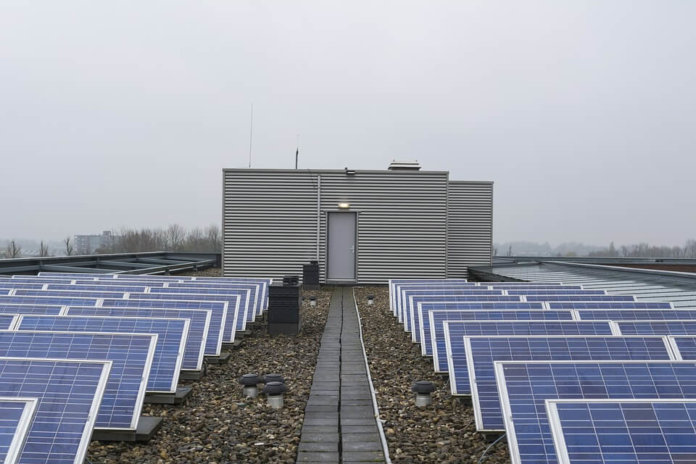Editor’s note: The dollar investment figure (from $1.2 trillion to $620 billion) was corrected by BNEF on Nov. 15 following their discovery of a totaling error. The GW and GWh capacity figures are not affected, and neither are the overall findings. BNEF apologizes for the mistake.
Citing the tumbling cost of batteries, a new report from Bloomberg NEF (BNEF) says the global energy storage market, excluding pumped hydro, is expected to attract $620 billion in investment from now until 2040.
BNEF has significantly increased its forecast for the global deployment of behind-the-meter (BTM) and grid-scale batteries over the coming decades. The research organization says the global energy storage market is set to grow to a cumulative 942 GW/857 GWh over the next 22 years.
Importantly, BNEF points out, cheap batteries mean that wind and solar will increasingly be able to run when the wind isn’t blowing and the sun isn’t shining.
BNEF’s latest Long-Term Energy Storage Outlook sees the capital cost of a utility-scale, lithium-ion battery storage system sliding 52% between 2018 and 2030, on top of the steep declines seen earlier this decade. This will transform the economic case for batteries in both the vehicle and the electricity sector, the report says.
“We have become much more bullish about storage deployments since our last forecast a year ago. This is partly due to faster-than-expected falls in storage system costs, and partly to a greater focus on two emerging applications for the technology – electric vehicle charging and energy access in remote regions,” states Yayoi Sekine, energy storage analyst for BloombergNEF and co-author of the report.
Logan Goldie-Scot, head of energy storage at BNEF, adds, “We see energy storage growing to a point where it is equivalent to seven percent of the total installed power capacity globally in 2040. The majority of storage capacity will be utility-scale until the mid-2030s, when behind-the-meter applications overtake.”
BTM installations will be sited at business and industrial premises and at millions of residential properties. For their owners, they will perform a variety of tasks, including shifting grid demand in order to reduce electricity costs, storing excess rooftop solar output, improving power quality and reliability, and earning fees for helping to smooth voltage on the grid, the report explains.
China, the U.S., India, Japan, Germany, France, Australia, South Korea and the U.K will be the leading countries, according to BNEF. These nine markets are expected to represent two-thirds of the installed capacity by 2040. In the near term, South Korea will dominate the market, and the U.S. will take over in the early 2020s but then be overtaken by China, which will then lead to 2040.

Developing countries in Africa will also see rapid growth in battery storage, BNEF predicts. Utilities are likely to “recognize increasingly that isolated assets combining solar, diesel and batteries are cheaper in far-flung sites than either an extension of the main grid or a fossil-only generator,” the report explains.
The BNEF analysis estimates an energy storage build-out across multiple applications to meet variable supply and demand and to operate the grid more efficiently. It also takes into account customer-sited economics for using storage, as well as system-level needs. Aggregating BTM energy storage could be a viable alternative to utility-scale for many applications, but it will take years before regulatory frameworks in some countries fully allow this, the report says.
BNEF points out there is significant opportunity for energy storage to provide flexibility – to help balance variable supply and demand – and systems will undoubtedly be used in complex ways. Energy storage will become a practical alternative to new-build generation or network reinforcement, the report adds. In addition, BTM storage will increasingly be used to provide system services on top of customer applications.
Despite the rapid growth from today’s levels, demand for batteries for stationary storage will make up only 7% of total battery demand in 2040, according to the forecast. It will be dwarfed by the electric vehicle market, which will more materially impact the supply-demand balance and prices for metals such as lithium and cobalt.





But why only battery storage why don’t we look at other options I have in mind, pl check with me.